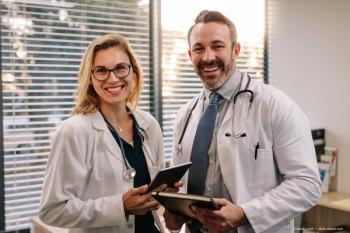
Ophthalmologists at ground level of COVID-19 fight
As the novel coronavirus, COVID-19, continues to spread around the world, ophthalmologists can be at risk each time they see a patient who may be exhibiting symptoms of the disease.
The novel coronavirus, COVID-19, continues to spread around the world, with more than 83,000 cases of the disease confirmed in 53 countries, and a global death toll of more than 2,800.
As governments search for answers as the coronavirus makes its way around the world, ophthalmologists can be at risk each time they see a patient who may be exhibiting symptoms of the disease.
In the United States, the
COVID-19, which first sickened people in China in December, is thought to have passed from animals to humans, like many similar pathogens. The symptoms of the disease include cough, fever and shortness of breath. However, little is known about its origins, and there has been no confirmation of its origin by any peer-reviewed scientific research, academic expert or public health organization.
Coronaviruses are a large family of viruses that cause illness ranging from the common cold to more severe diseases. Similar viruses cause severe acute respiratory syndrome (SARS) and Middle East respiratory syndrome (MERS), according to the
CDC testing
Last week, the CDC announced that it will commence testing individuals with flu-like illness for COVID-19 at public health labs in San Francisco, Los Angeles, Chicago, Seattle, and New York City. The CDC hopes to extend the initiative nationally.
Amid concerns, the medical community is poised to take steps to help stem the spread of the coronavirus, and ophthalmologists find themselves at ground zero. Ophthalmologists rely heavily on physical examination during patient consultation, creating some concern for the potential spread of COVID-19 from patients. The ophthalmologist is close to the patient during the slit lamp microscope examination, with droplets from a cough or sneeze easily covering the distance between patient and ophthalmologist.
Peter J. McDonnell, MD, chief medical editor of Ophthalmology Times®, and director of the Wilmer Eye Institute, Johns Hopkins University School of Medicine, Baltimore, said it absolutely is a concern for ophthalmologists, optometrists, technicians and everyone involved in the office visit.
“If the virus does enter the U.S. population, it will be important for all of us to screen patients at the time the appointment is made and or when they arrive (do they have any signs or symptoms consistent with flu, colds, etc.), have they traveled to affected areas, etc.,” he said. “Patients with risk factors present should be triaged appropriately.”
For example, people with non-urgent problems or just wanting a checkup and new glasses can be deferred until their respiratory symptoms resolve. Dr. McDonnell noted that precautions that should be used for all patients apply, including hand washing, appropriate technique to handle fluids, sterile tonometer tips, etc.
“The use of masks that are capable of preventing inhalation of the virus (not standard surgical masks) and gloves when a potentially infected patient is seen are certainly indicated,” he added.
A medium for infection
With previous viral outbreaks, such as SARS, tears proved to be a potential medium for infection. Dr. McDonnell noted that this appears to be the case with COVID-19, citing the case of Li Wenliang, MD, a Chinese ophthalmologist who is credited with being the first medical professional to sound the alarm on the new virus.
According to news reports, he saw seven patients with a SARS-like infection with conjunctival involvement in his hospital in Wuhan. In December, Dr. Li, 34, tried to send a message to his medical school classmates to alert them to this observation and urge them to be careful. Three days later, police visited Dr. Li and told him to stop. He returned to work and caught the virus from a patient. He had been in hospital for at least three weeks before his death from the virus.
Since that time, coronavirus has continued to spread. In fact, the origin of one case, a woman in California, has been impossible for doctors to trace. The prompted the CDC to warn the United States has likely seen its first case of "community spread."
Dr. McDonnell said he believes what will happen going forward depends very much on the scenario that unfolds in the United States.
“If an epidemic does occur, I believe most persons will defer elective visits to their doctors and that is appropriate,” he said. “Things like elective cataract surgery will drop for a while, while patients with more urgent problems will present in our offices, hospitals and surgery centers and we will care for them while segregating them as much as possible from individuals with or suspecting to have the coronavirus.”
Physicians must make sure that their practice has appropriate protocols in place and a stock of personal protection equipment, including eye protection, face masks and a supply of N-95 masks.
Travel issues
There are several annual meetings that often attract a global audience, and organizations are taking a cautious approach with the cloud of COVID-19 looming.
The
The ESCRS also offered some precautions recommended by the WHO:
- Do not travel if you have a fever and cough
- Wash your hands frequently and thoroughly with water and soap
- When sneezing or coughing, cover mouth and nose with a tissue (not your hands!) or sneeze or cough in the crook of your arm; discard tissue immediately into a closed bin and clean your hands
- Avoid touching eyes, nose and mouth
- Avoid direct contact with sick people
- If you have fever, cough and difficulty breathing, seek medical care early
In the United States, there are several high-profile shows this year, including the
Regarding its annual meeting in Seattle, in a statement, ASRS officials said "leadership is actively monitoring developments concerning COVID-19 and staying abreast of updates from health organizations responsible for tracking and responding to the virus, including the Centers for Disease Control and Prevention (CDC), World Health Organization (WHO), Washington State Department of Health, and King County Public Health. In addition, we are closely monitoring all travel alerts issued by the U.S. Department of Homeland Security. As our meeting approaches, we will rely on these authorities to provide us guidance and take appropriate steps, if necessary, to ensure the safety of our participants."
In the meantime, ASRS officials are encouraging members to monitor the CDC website for additional information and recommendations for protecting themselves from an infection.
In a statement, AAO said, “it is monitoring the situation and advice from health authorities, and keeping our members and employees informed. The Academy meeting (AAO) is still nine months away and it is too soon to know what impact it will have on attendance.”
Newsletter
Don’t miss out—get Ophthalmology Times updates on the latest clinical advancements and expert interviews, straight to your inbox.













































